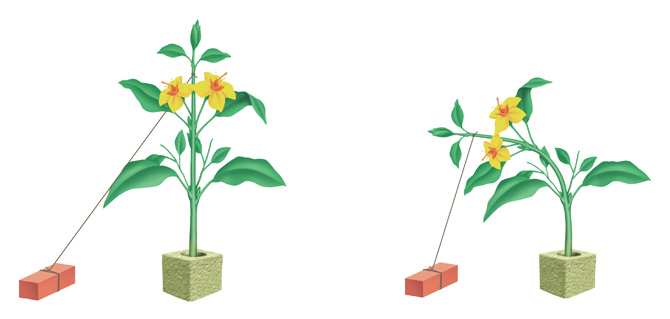
 |
|
Hydroponics - Indoor HorticultureHydroponics - Indoor Horticulture represents an educational, in-depth,
up-to-date,
indoor horticultural growers guide that covers all principles of indoor Hydroponics - Indoor Horticulture examines, explores, dissects and
presents a fully comprehensive step by step growers guide, relating
to all and every aspect of indoor hydroponic horticulture, with complete
chapters on plant biology, propagation, hydroponic systems, nutrients,
oxygen, carbon dioxide enrichment, pH, biological pest control, fungi/disease,
cuttings/clones, pruning/training, breeding, harvesting, equipment,
grow rooms, a full history of hydroponics, and more. |
| (Below follows a one page
sample taken from the book) |
||
 |
||
At this point, tie the plant back to canes or a weight on the floor to prevent it from bending back to the upright position. After a couple of days, the plant will have adjusted to this new growing position and once more you can force the stem back some more without breaking it, tying it back until it has got used to this new position. In doing this to all stems above a certain height, you can restrict the height of your plant, encouraging it to grow sideways and down on itself and then up. Some growers employ this technique purposefully to gain better control of their plants. This is typically because of the confines of their particular grow room. At this point, tie the plant back to canes or a weight on the floor to prevent it from bending back to the upright position. After a couple of days, the plant will have adjusted to this new growing position and once more you can force the stem back some more without breaking it, tying it back until it has got used to this new position. In doing this to all stems above a certain height, you can restrict the height of your plant, encouraging it to grow sideways and down on itself and then up. Some growers employ this technique purposefully to gain better control of their plants. This is typically because of the confines of their particular grow room. |
If when reading this book you suddenly realise with a sinking feeling in your gut that this is your current predicament, take a deep breath, because the only choice you now have, is a radical one. If your plants have outgrown the lights and are already above them with good sized fruit or flower formations, then you have to employ a technique of snapping! If correctly carried out, this technique is not as bad as it sounds. Approximately 1-1.5 feet beneath the grow lights, with your fingers and thumb gently, but persuasively, snap the plant at a 90° right angle, and when doing so, make sure you do not over snap it, and although your plant stem is broken, it is still in one piece. Gently do it in a way where the plant can just about support the 90° bend. If you have over snapped the stem, then employ some type of support to keep the snapped joint at a 90° angle. When employing this procedure on many plants at the same time, you can make an interconnecting canopy directly under the lights using the plants to support the other plants. After 2 to 4 days, the plants heal and the right angle bend becomes a stiff joint and the plants, although put through some stress during this period, will carry on growing as if nothing has happened but with the greatly added benefit of being bathed in light, which in turn will produce a much bigger yield. |
|
|
 |